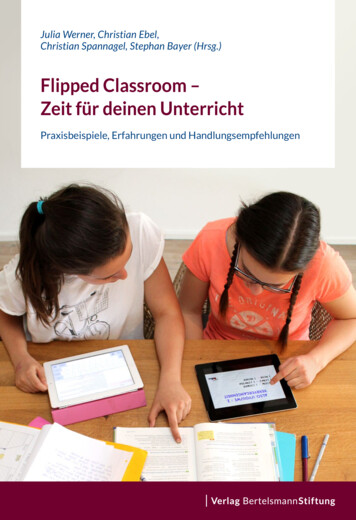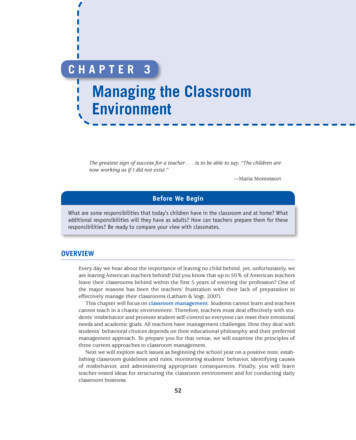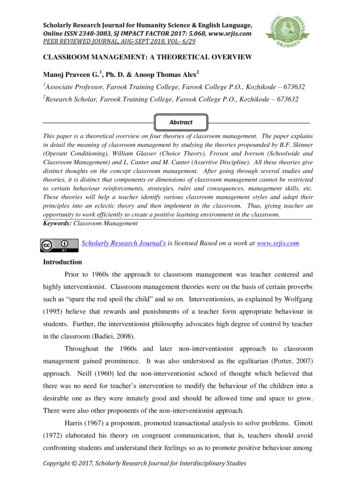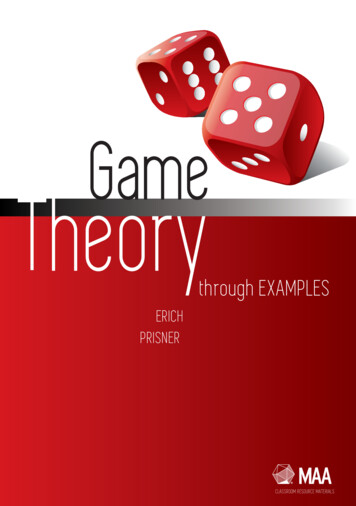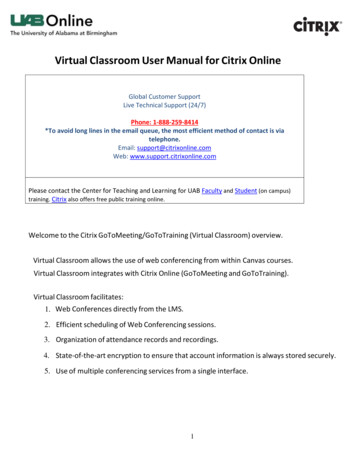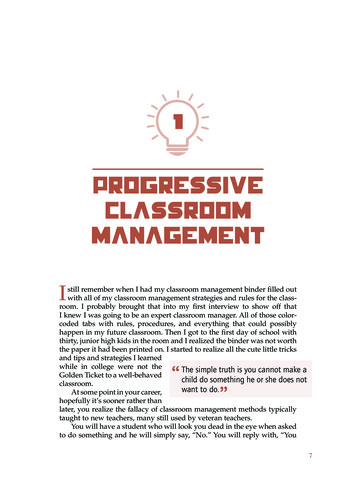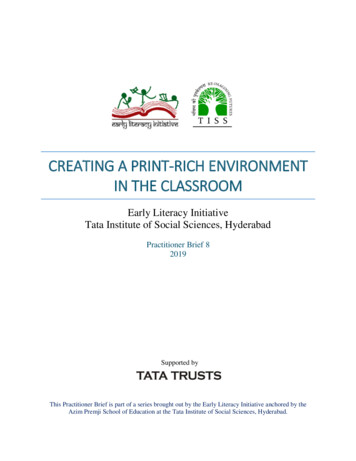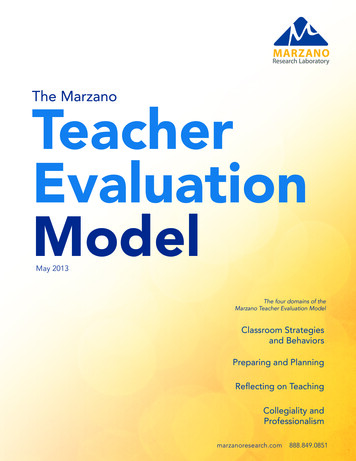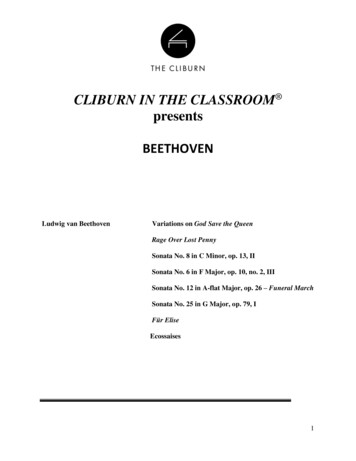
Transcription
CLIBURN IN THE CLASSROOM presentsBEETHOVENLudwig van BeethovenVariations on God Save the QueenRage Over Lost PennySonata No. 8 in C Minor, op. 13, IISonata No. 6 in F Major, op. 10, no. 2, IIISonata No. 12 in A-flat Major, op. 26 – Funeral MarchSonata No. 25 in G Major, op. 79, IFür EliseEcossaises1
TEKS CORRELATIONSLanguage Arts Strand2.1, 3.1, 4.1 Listening/Speaking/Purposes. The student listens attentively and engages activelyin various oral language experiences.2.2, 3.2, 4.2 Listening/Speaking/Culture. The student listens and speaks to gain knowledge ofhis/her culture, the culture of others, and the common elements of cultures.2.4, 3.4, 4.5 Listening/Speaking/Communication. The student communicates clearly by puttingthoughts and feelings into spoken words.2.5, 3.5, 4.6 Reading/Word Identification. The student uses a variety of word identificationstrategies.2.7, 3.7, 4.8 Reading/Variety of Texts. The student reads widely for different purposes in variedsources.2.8, 3.8, 4.9 Reading/Vocabulary Development. The student develops an extensive vocabulary.2.9, 3.9, 4.10 Reading/Comprehension. The student uses a variety of strategies to comprehendselections read aloud and read independently.2.10, 3.10, 4.11 Reading/Literary Response. The student responds to a variety of texts.2.12, 3.12, 4.13 Reading/Inquiry/Research. The student generates questions and conductsresearch using information from various sources.2.13, 3.13, 4.14 Reading/Culture. The student reads to increase knowledge of his/her culture,the culture of others, and the common elements of culture.2.14, 3.14, 4.15 Writing/Purposes. The student writes for a variety of audiences and purposesand in various forms.2.15, 3.15, 4.16 Writing/Penmanship/Capitalization/Punctuation. The student composesoriginal texts using the conventions of written language, such as capitalization and penmanship,to communicate clearly.2.16, 3.16, 4.17 Writing/Spelling. The student spells proficiently.2.17, 3.17, 4.18 Writing/Grammar/Usage. The student composes meaningful texts applyingknowledge of grammar and usage.2.20, 3.20, 4.21 Writing/Inquiry/Research. The student uses writing as a tool for learning andresearch.Music Strand2.5, 3.5, 4.5 Historical and cultural relevance. The student examines music in relation tohistory and cultures.A. The student examines short musical excerpts from various periods or times in history anddiverse and local cultures.B. The student will examine short musical excerpts from various periods or times in history anddiverse and local cultures.C. The student identifies simple interdisciplinary concepts relating to music.2.6, 3.6, 4.6 Critical evaluation and response. The student listens to, responds to, andevaluates music and musical performances.A. The student will begin to practice appropriate audience behavior during live or recordedperformances.2
B. The student will recognize known rhythmic and melodic elements in simple aural examplesusing known terminology.C. The student will distinguish between rhythms, higher/lower pitches, louder/softer dynamics,faster/slower tempos, and simple patterns such as changes in timbre, form, tempo, ordynamics using appropriate vocabulary in musical performances.D. The student will respond verbally or through movement to short musical examples.E. The student will describe a variety of compositions and formal or informal musicalperformances using specific music vocabulary.F. The student will justify personal preferences for specific music works and styles using musicvocabulary.Social Studies Strand3.1 History. The student understands how individuals, events, and ideas have influenced thehistory of various communities.2.2, 3.3 History. The student understands the concepts of time and chronology.2.3 History. The student understands how various sources provide information about the past.2.5, 3.5, 4.6 Geography. The student understands the concepts of location, distance, anddirection on maps and globes.3.14 Culture. The student understands the importance of writers and artists to the culturalheritage of communities.2.15 Culture. The student understands the significance of works of art in the local community.2.17, 3.16, 4.22 Social Studies Skills. The student applies critical thinking skills to organize anduse information acquired.2.18, 3.17, 4.23 Social Studies Skills. The student communicates effectively in written, oral, andvisual forms.SUGGESTED LESSONS PLANSHappy Birthday, Beethoven! pages 4–7Move to it with a Mood page 8–10Interviewing a Composer page 11–13Beethoven Biography page 143
Happy Birthday, Beethoven!Celebrate Beethoven’s 248th birthday! Students will share their families’ traditions forcelebrating birthdays.Subject Areas: Social Studies, Language Arts, MusicInstructional Goals: Students will explore the traditions across the globe that people use to celebratebirthdays. Students will apply traditions to celebrate the life of Beethoven. Students will research historical significance of people who possess virtuosity. Students will use metacognition in determining salient information.Materials needed: Internet access Reference materials Notebook paper White card stock Markers, crayons, colored pencilsActivity:1. Ask the students to write down a family birthday celebration on a music note and postthem on a musical score drawn on butcher paper or on chart paper.4
2. Students will share family traditions and research birthday traditions around the world.The following websites have great information on the history of /www.birthdaycelebrations.net/traditions.htm3. Students may create birthday cards for Beethoven from around the world.Traditions from Around the World:How Happy Birthday is Said Albanian: “Gëzuar ditëlindjen”Bosnian: “Sretan rođendan”Bulgarian: “Chestit Rozhden den”Catalan: “Per molts anys”Cheinese: “Shēngrì kuàilè”Czech: “Všechno nejlepší k narozeninám”Danish: “Tillykke med fødselsdagen”Dutch: Fijne verjaardag”Filipino: “Maligayang kaarawan”Finnish: “Hyvää syntymäpäivää”French: “Bon anniversaire”Galician: “Feliz Aniversario”German: “Alles Gute zum Geburtstag”Greek: “Charoúmena genéthlia”Hawaiian: “Hauʻoli lā hānau”Hebrew: “ ”יום הולדת שמח Hungarian: “Boldog születésnapot”Icelandic: “Til hamingju með afmælið”Igbo: “Ezi ncheta ọmụmụ”Indonesian: “Selamat ulang tahun”Irish: “Lá breithe shona duit”Italian: “Buon compleanno”Japanese: zakh: “Twğan küniñ quttı bolsın”Khmer: “Rikreay thngai kamnaet”Korean: “Saeng-il chugha”Kurdish: “Rojbûna te pîroz be”Latin: “Felix natalis”Lithuanian: “Su gimtadieniu”Luxembourgish: “Alles Guddes fir däi Gebuertsdag”Malay: “Selamat Hari lahir”Mongolian: “Төрсөн өдрийн мэнд”Nepali: “Janmadinakō”Norwegian: “Gratulerer med dagen”Polish: “Wszystkiego najlepszego”5
Portuguese: “Feliz Aniversário”Romanian: “La multi ani”Russian: “S dnem rozhdeniya”Serbian: “Srećan rođendan”Slovenian: “Vse najboljše”Somali: “Dhalasho Wacan”Spanish: “Feliz cumpleaños”Swahili: “Siku ya kuzaliwa ya furaha”Swedish: “Grattis på födelsedagen”Tai: “S̄uk̄hs̄ạnt ̒ wạn keid”Turkish: “Doğum günün kutlu olsun”Ukranian: “Z Dnem narodzhennya”Vietnamese: “Chúc mừng sinh nhật”Welsh: Penblwydd hapus”Zulu: “Usuku olumnandi lokuzalwaTeacher’s Role:The teacher’s role is to facilitate the discussion of traditions and how traditions may bemanifested within specific cultures.Creative Question Suggestions:1. How might you celebrate the birthday for someone observing their 248 th year?2. How would your family’s traditions for celebrating birthdays be received byBeethoven?Evaluation:1. The students will be evaluated on their research notes on the birthday traditionsacross the globe.2. The students will be evaluated on their birthday cards from across the world toBeethoven.Move to It with a Mood!6
Subject Areas: MusicInstructional Goals:* Students will create movements to selected pieces ofmusic.* Students will understand the role ofprogram music in music history.*Students will understand how program music affectsthe mood of the listener.(Program music is a type of Art Music that attempts tocreate an extra-musical narrative, or tell a storythrough music without words.)Materials:* Simple props (scarves, ribbons, etc.)*Recording of Beethoven’s music: “Rage Over Lost Penny”; Sonata, Op. 13, 2nd mvmt; Sonata,op. 10, No. 2, 3rd mvmt; Sonata, Op. 26 (Funeral March); and Sonata, Op. 70, 1st mvmt.*A recording for each groupAnticipatory Set:1. The teacher will play selected pieces of music written by Beethoven.2. The teacher will ask students to imagine a scenario or activity after each piece is played;students will suggest movements that might go with the activity.3. The teacher will ask a student leader to do a movement as the other students mirror thestudent.4. The teacher will ask the students what mood each piece evokes as they listen.5. The teacher will give suggestions to the students on what kind of movement wouldmatch each piece.6. The teacher will use the attached worksheet to assist students in describing the aspectsof the music.Activity:1. Students will create movements that represents the mood of each piece.2. Students will use simple props to enhance their movement.3. Students will use the recording as they move.4. Students will write and brainstorm about their movement for their piece.5. Students will depict the emotions and mood of their song in their movement.6. Student will perform their movement for the class.Creative Question Suggestions:1. How does the mood of each song help you decide how to move?2. How does movement help you understand the music?7
3. Was this activity easy or difficult? What made it so? Did you find it easy or frustrating?Why?Evaluation:1. Students will be evaluated on their cooperation with their classmates. Did they workwell within their assigned personal movement group?2. Did the students produce movement that demonstrates an understanding of the music?3. Were the students able to easily communicate their ideas about musical movement intheir writing?8
9
Interviewing a ComposerSubject Areas:Music, Language ArtsInstructional Goals:* Students will understand the research process.* Students will work in pairs to simulate an actual televisionnewsinterview.* Students will understand that composers are important to the cultural heritage ofcommunities.Materials:* Composer biography* KWL Chart* Learning Log* Optional: costumes for the reporter and the composerAnticipatory Set:1. The teacher will lead students in a discussion about television interviews.2. The students will create a criteria chart on what constitutes a good television interview.Activities:1. Students will be allowed to select a partner.2. The partner groups will begin a KWL chart on Beethoven to prepare them for theirtelevision interview. The groups should read the biography text for Beethoven and iftime allows, they can continue their research into the composer with reference books,library resources, internet resources, etc. and continue adding to their KWL charts.3. Students will write their own interview questions and answers for their presentations.Use world and regional maps to locate where the composer lived and consider howculture of his country would impact the composer’s lifestyle, music, and personality.(Remember the answers are to be done in first-person, as the student will be taking onthe persona of the composer.)4. Students will present their interviews to the class. Students can evaluate other groupsusing the previously created class criteria chart.5. It time permits, students can create a print advertisement to promote their interviewsand attract “viewers.” (Technology variations: students can use digital cameras to takephotos for the print advertisement and use Word Publisher or PowerPoint applicationsto create the advertisement.)6. The students will write in their learning logs to reveal the knowledge they gained whileresearching Beethoven and evaluating other groups’ presentations.10
Teacher’s Role:The teacher’s role in this activity is to direct the class to create a strong criteria chart onconducting an interview. Once students understand what is expected they will be able tocreate an interview based on their research.Creative Question Suggestions:1. How will your group’s portrayal of the composer reveal his personality, culture, and life?2. Evaluate the history of the country where the composer lived. How might historicalevents impact the composer and his music?Evaluation:1. Students will be evaluated on their interview presentations. Did the team cooperatewith each other to complete the assignment (KWL chart, interview questions andanswers that are well thought-out, and a creatively presented interview)?2. Did the students produce a believable interview that mirrors the factual information oftheir composer? Did they take on the personas of the television interviewer and thecomposer?11
12
THE STORY OF LUDWIG VAN BEETHOVEN(1770–1827)Ludwig van Beethoven was born in Bonn, Germany. His father and grandfatherwere both musicians. Beethoven started lessons in piano, violin, andcomposition with his father when he was 4 years old.Later in his life, Beethoven moved to Vienna, Austria. In Vienna, he was able tomeet some of the finest musicians of his day, and to play his music for them.This was a happy time for him, and he had great success.Beethoven loved nature, and he spent many holidays in the park where he tooklong walks. Sometimes, he saw things outdoors that inspired him to writemusic.Beethoven started to lose his hearing when he was about 30 years old. Thismeant that he could not give concerts anymore, but he did keep writing music.In fact, some of his most famous pieces were written after he lost his hearing.Beethoven became known as one of the greatest pianists of his day, and isconsidered one of the greatest composers in history. He played an importantrole in the development of Classical music as a whole, and music for the piano inparticular.13
2. The partner groups will begin a KWL chart on Beethoven to prepare them for their television interview. The groups should read the biography text for Beethoven and if time allows, they can continue their research into the composer with reference books, library resources, internet re

